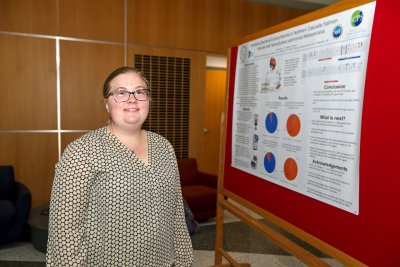SSRP Abstract
Assessing Bacterial Endosymbionts in Northern Cascade Salmon Infected With Nanophyetus salmincola Metacercaria
 Student: Catie Babbs ’21
Student: Catie Babbs ’21
Research Mentor: Stephen Greiman (Georgia Southern University Department of Biology)
Current progress of the reintroduction of Grizzly bears into the North Cascades of Washington has been hindered due to an unknown pathogen. The culprit was eventually determined to be a bacterial pathogen transmitted by a parasitic worm, i.e. Neorickettsia SF agent. This bacterial pathogen is endosymbiotic within the digenean Nanophyetus salmincola, which use fishes as their second intermediate host. Grizzly bears were becoming infected with the parasite and subsequently the bacteria after ingesting infected salmon. Unfortunately, little is known on the strain diversity of this bacteria, the distribution or prevalence of the parasite (N. salmincola), or the distribution or prevalence of Neorickettsia SF agent. Therefore, this project had two major aims, determining the prevalence of the parasite N. salmincola and Neorickettsia SF agent bacteria. Kidney and muscle tissue of chinook salmon samples were collected from Wenatchee and Metatchee rivers and N. salmincola metacercariae (mtc) were isolated using a pepsin HCL solution. A total of 215 mtc were isolated from 105 salmon. Metacercariae were pooled into groups of 10 and DNA was extracted. DNA extractions were screened for the presence of Neorickettsia SF agent using a newly developed TaqMan real-time PCR assay. Samples testing positive were verified by nested PCR and sequencing of a 1900 bp fragment of the GroESL operon. Overall prevalence of N. salmincola mtc was high at 92.10%, while the prevalence of SF agent was low at 1.86%.
As Grizzly bears were being reintroduced into Washington state, they were becoming sick and dying. The culprit was determined to be Neorickettsia SF agent bacteria that reside within Nanophyetus salmincola parasite that reside within Chinook salmon that the bears were eating. This project determined that the prevalence of Nanophyetus salmincola parasite was high, while the Neorickettsia SF agent bacteria prevalence was low. Though the prevalence of the bacteria was low, any kind of prevalence could cause death in the Grizzly bears that were eating them.
